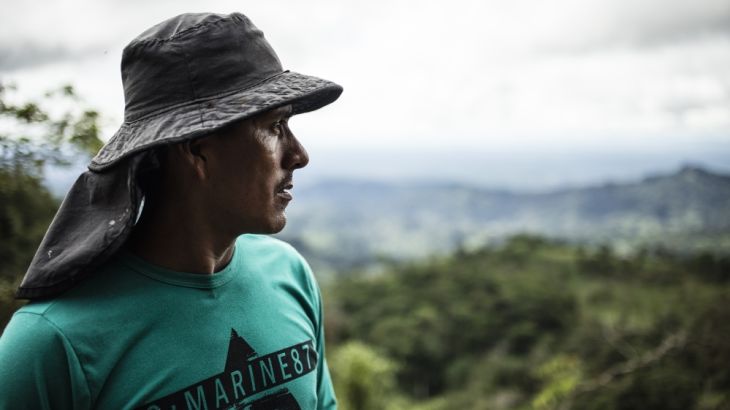
In Enemy Territory: A Colombian Social Leader’s Act of Defiance
Trapped between Colombian army and a paramilitary group, a farming community risks a journey to remember the fallen.
In Colombia‘s northwest mountains of Uraba lies a farming community that calls itself the “Peace Community of San Jose de Apartado”.
Led by German Graciano, the community has lived in the midst of conflict for nearly 20 years.
Keep reading
list of 4 itemsColombia agrees with ELN rebel group to extend truce
Amid uptick in kidnappings, Colombian family receives ‘biggest gift of all’
Her son was killed by the Colombian military. Now, she’s getting an apology
Since it was founded in 1997, more than 300 members of the peace community have been killed either by the FARC, the Colombian army or right-wing paramilitary groups.
In memory of the fallen, Graciano leads his people, including the elderly, women and children, through the mountainous region to pay their respects to slain community members.
It is a risky journey that community members have chosen to embark on as an act of defiance against a hostile right-wing paramilitary group. The Autodefensas Gaitanistas de Colombia, also known as the AGC and Clan del Golfo, is a threat to the Peace Community, having tried and failed to assassinate Graciano.
But Graciano is not the only community leader facing death threats. Others have not been so fortunate. Since the landmark peace agreement between the Colombian government and the FARC rebels in 2016, more than 700 social leaders have been reported killed across the country.
FILMMAKER’S VIEW
By Ramon Campos Iriarte and Alejandro Bernal Rueda
It was the promise of a new Colombia, of possible long-term peace. After more than 50 years of civil war, the country made international headlines when the government signed a landmark peace deal with the FARC fighters. That was the end of 2016.
However, fast forward to today, the socioeconomic and political conditions that motivated the uprising of the rebels in the 1960s have changed very little in large portions of Colombia: Chronic poverty and governmental abandonment continue to drive conflict in rural areas and remote jungles.
Despite the hope for stability after the peace process, a power void was created in various parts of Colombia. It brought about conflict among the remaining warring forces, and created a widespread land-grab phenomenon across resource-rich territories.
The effects of the war on civilian communities and civic leaders have worsened, paradoxically, under the new conditions resulting from the retreat of the FARC fighters.
The San Jose de Apartado Peace Community is a small village of about 600 people living a few kilometres outside of Apartado, a sprawling town on the eastern edge of the Gulf of Uraba, in Colombia’s northwest.
Tired of the killings, the threats and being on the run, a group of farmers decided to congregate in San Jose de Apartado because of the violence perpetrated by the Colombian army and paramilitaries.
On March 23, 1997, the group declared itself a “peace community”: They would be strictly neutral in the face of all armed actors. It was a strategy aimed at garnering enough attention to prevent harassment.
The farmers pledged to implement a new community model based on self-governance and communal production, and despite its small size, the newly-born agrarian, anti-war movement became an uncomfortable thorn by the side of a troika of illicit complicity made up by right-wing paramilitary groups, landowners and corrupt local authorities.
At the heart of the community today is Graciano, from the mountains of Uraba, who spent his childhood running and hiding from the atrocities of Colombia’s gruesome war, along with his parents and siblings.
In total, Graciano recounts, 13 of his relatives have been killed by paramilitaries together with members of the Colombian army, and also by FARC fighters.
Following the steps of Gildardo Tuberquia, one of the founding leaders of the Peace Community who took him under his wing, Graciano has been determined to resist the pressure and the threats from armed groups, a stance that could easily turn into a death sentence in Uraba.
It is reported that more than 700 social leaders like Graciano have been killed across Colombia in the three years since the peace deal was signed. The government has yet to show a real commitment to stop the killings.
Our documentary, In Enemy Territory, is an immersive film that journeys through a part of Colombia where survivors of conflict have been building a process of memory and resistance in the midst of confrontation. It is the daily bread of the forgotten and marginalised.
The film follows Graciano on a risky pilgrimage around the settlements of the Peace Community, which are scattered around a remote and wild expanse that is currently under the tight grip of the Autodefensas Gaitanistas de Colombia or Clan del Golfo, the country’s largest and extremely violent paramilitary group.
The documentary explores the connection between the dynamics of conflict and human rights violations in this South American nation. The prevailing vicious circle of violence and dispossession in Colombia, which the peace agreement failed to address, is one of the most critical focuses of instability in the region today.